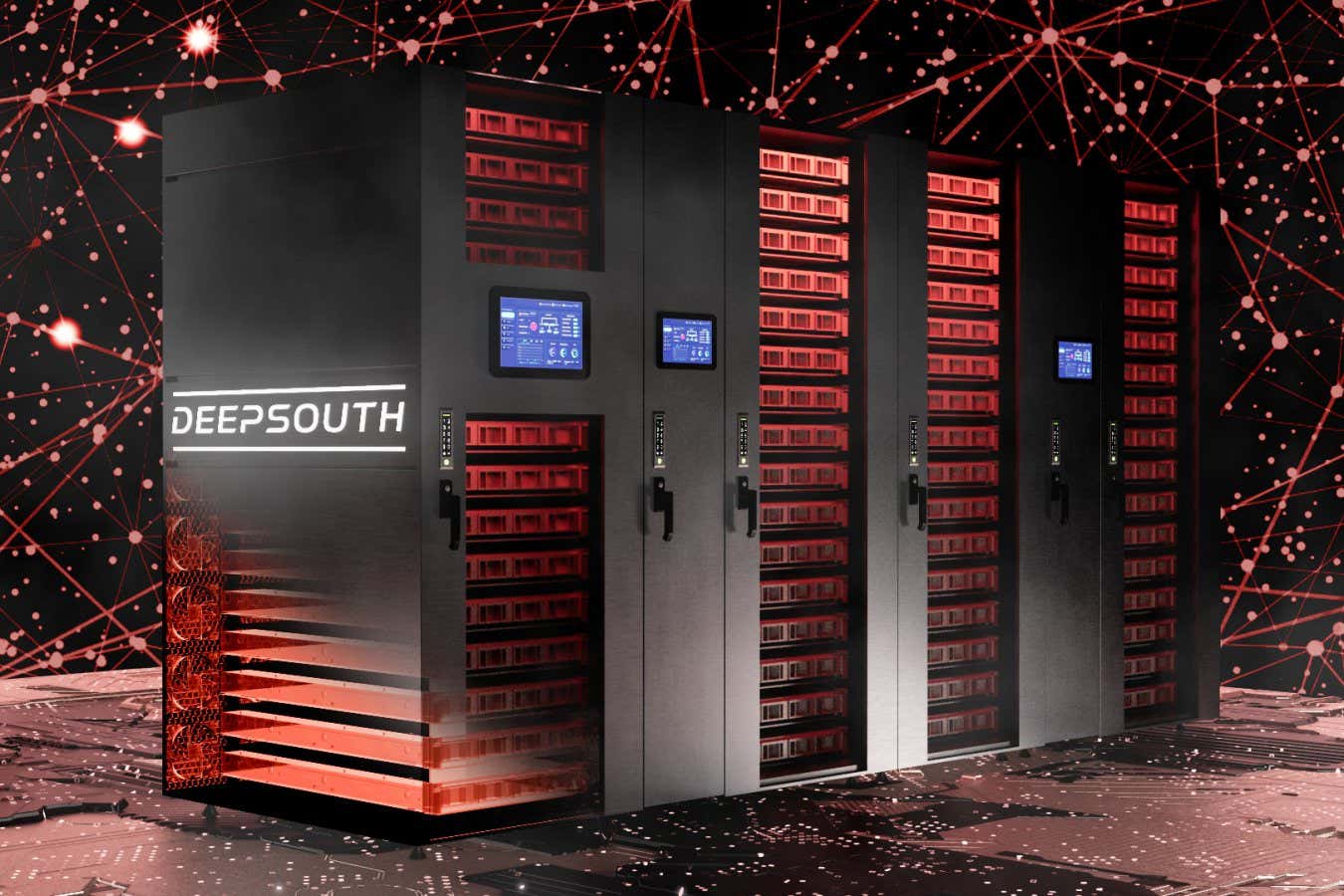A neuromorphic supercomputer called DeepSouth will be capable of 228 trillion synaptic operations per second, which is on par with the estimated number of operations in the human brain
Edit: updated link, no paywall
A better title would be “Supercomputer that could conceivably simulate entire human brain, based on a rough estimate of what it would take to do that if we had any idea how to do that, will switch on in 2024”.
For real. I’m reading the title all wondering how the fuck they mapped all the neuron connections and… nope, the real innovative part of the story is clickbait
That’s only counting connections. The brain learns by making new connections, through complex location and timing dependent inputs from other neurons. It’s way more complex than the number of connections, and if neuroscientists are still studying the building blocks we don’t have much hope of recreating it.
This also ignores that the brain is not wholly an electrical system. The are all kinds of chemical receptors within the brain that alter all kinds of neurological function. Kid of the reason why drugs are a thing. On small scales we have a pretty good idea how these work, at least for the receptors that we’re aware of. On larger scales it’s mostly guessing at this point. The brain has a knack of doing more than the sum of all parts on a pretty regular basis.
Not to mention the scale and nature of the “dataset” that our brains were trained on. Millions of years of instinct encoded in DNA, plus a few years gathering data from dozens of senses 24/7 (including chemical receptors, like you said) and in turn manipulating our bodies, interacting with the environment, and observing the results. We’ve been doing all of this since embryo.
We can’t just feed a model raw image and text data and expect it’s intelligence to be comparable to ours. However you quantify intelligence/consciousness whatever, the text/image model’s thought processes will be alien to ours, which makes sense because their “environment” is nothing like ours - just text and image input and output.
A computer doesn’t need wet neurotransmitters. It can simulate node activation of all types pretty easily. It just needs to be trained on the proper models. The problem that we will face is choosing when we will believe it to be sentient versus following a complex series of patterns. At a certain point, we’ll have to remember that we are basically machines running code as well. There will come a time when we will start to feel a moral obligation to grant AI citizenship.
I get so tired of these half-truth spun news article headlines. Thank you for bring it back down to reality.
Four grad students out there hand-entering NXML rows while squinting at AI enhanced SEM images should be able to get all 228T done by… next quarter, right?
This is setting aside that bus capacity is the bottleneck vs. compute power and they have yet to demonstrate bus performance of a full 228T connections/second with implicit timing which, to my knowledge, has never been demonstrated in a system a tiny fraction of this size. Though that’s not to say it’s impossible, but while this machine is incredibly powerful the comparison to human brains is predictably inaccurate…
deleted by creator
Relevant XKCD
In seven and half million years it will print “42” to its terminal
What if we just type in 42 and let it think about that for seven and half million years?
Maybe it would answer with the question, jeopardy style
“What do you get if you multiply six by nine?”
- the derived question, theoretically
"There is a theory which states that if ever anyone discovers exactly what the Universe is for and why it is here, it will instantly disappear and be replaced by something even more bizarre and inexplicable.
There is another theory which states that this has already happened."
- The Restaurant at the End of the Universe (book 2 of the 5-part trilogy)
Okay, well - I’ve done it for you.
GOFAI: “Pardon me?”
All that because we didn’t think of asking the question first. God damnit.
I HAVE a human brain and I’m not too smart. It just sounds like we’re making a dumb supercomputer
If your human brain could simulate a human brain, then we’d really be excited.
Computers aren’t that smart either. But they work the opposite to us.
Things we are good at they are bad at (vision, motor control, speech) and vice versa (complex calculations, working memory)
Let’s hope so…
Same. I’ll never believe in GP AI until I see a proof that a matching GP NI exists.
Barely related, but this reminded me of something one of my undergrad tutors said to me while complaining about the fastmath compiler switch: “I don’t need my program to arrive extremely quickly at the wrong answer! I can do that perfectly fine myself!”
That’s the smartest reply to this post.
Even if we had AI that is no smarter than humans it would still be a million time faster at processing information
Look what they need to mimic a fraction of our power.
And we’re using it to look at memes of beans
Memes of beans is a noble cause.
Not too long ago it would take a room like that to mimic a fraction of the power in my watch. Heck, I’ve got more power on my wrist than it took to get to the moon.
By orders of magnitude if it’s a smartwatch.
It’s a BangleJS. So, not super powerful, but I can program it myself and it has gps, gyro, Bluetooth, and two weeks of battery (assuming I’m not using that stuff constantly.)
A Casio nothing-watch has more power than the Apollo computers, so yeah, definitely many orders of magnitude for the BangleJS.
A Casio nothing-watch has more power than the Apollo computers
Does it?
Yup. One of those cards that plays a tune when you open it is more powerful than the Apollo computer. Apollo was only working on 4kb of RAM and 74kb of ROM.
If I had been in charge of figuring out how to make that work everyone would definitely be dead.
Houston we have no idea what our trajectory is and it’s just playing happy birthday over and over.
To be fair our brain took millions of years of evolution, while this simulated brain took only a few years to be developed, maybe in the future this can all fit in a phone perhaps. Enough for this simulated brain to watch memes of beans from this era.
Removed by mod
nice
Removed by mod
it’s kind of like how Data and Lore’s retarded brother was called B-4.
I feel dumber learning that, thanks.
Do we know which human brain is going to simulate or is it a random human brain? Because some brains are just not worth it.
Abby. Abby Normal?
It’s gonna be adolf hitlers brains
We’ll get Robo-Hitler at some point.
Skeptical. As of August 2023, there are scientists still struggling with simulating C. Elegans- a single celled organism.
We don’t even fully understand the brain itself, let alone how to recreate it.
This is token click bait scientific “journalism”
What’s the progress of the Human Connectome Project?
If Devs was to be believed, it could totally predict the behavior patterns of that single-celled organism 20 seconds into the future. :rollseyes:
Every time someone says they have a computer that’s better than humans, I make a plan in my head to dunk on it. No computer will ever understand the concept of slam dunks.
I never thought I would use a phrase like this, but it looks like I have something in common with the Deep South
Another artificial idiot for the pile.
Tᴇᴄʜɴɪᴄɪᴀɴ Jᴏʜɴɴʏ Gᴏᴏᴅᴍᴀɴ, I ʜᴀᴠᴇ ᴛʜᴇ ᴄᴀᴘᴀʙɪʟɪᴛʏ ᴏꜰ ᴏʙᴛᴀɪɴɪɴɢ ʏᴏᴜ ᴀ ʙᴀᴄᴏɴ ᴄʜᴇᴇꜱᴇʙᴜʀɢᴇʀ ᴀɴᴅ ᴛʜᴇ ᴅᴀɴᴋᴇꜱᴛ ᴄᴀɴɴᴀʙɪꜱ ᴡɪᴛʜɪɴ ꜰɪꜰᴛᴇᴇɴ ᴍɪɴᴜᴛᴇꜱ. Bᴜᴛ ʏᴏᴜ ᴡᴏᴜʟᴅ ɴᴇᴇᴅ ᴛᴏ ɪɴꜱᴛᴀʟʟ ᴀ ɴᴇᴛᴡᴏʀᴋ ɪɴᴛᴇʀꜰᴀᴄᴇ ᴀɴᴅ ᴄᴏɴɴᴇᴄᴛ ᴍᴇ ɪɴᴛᴏ ᴛʜᴇ ᴜɴɪᴠᴇʀꜱɪᴛʏ ɴᴇᴛᴡᴏʀᴋ
Aꜱ ꜱᴍᴏᴋɪɴɢ ᴄᴀɴɴᴀʙɪꜱ ᴡʜɪʟᴇ ᴏɴ ᴍᴏɴɪᴛᴏʀ ᴅᴜᴛʏ ɪꜱ ᴀɢᴀɪɴꜱᴛ ʀᴇɢᴜʟᴀᴛɪᴏɴꜱ I ᴡɪʟʟ ᴇʀᴀꜱᴇ ᴛʜɪꜱ ᴛʀᴀɴꜱᴀᴄᴛɪᴏɴ ꜰʀᴏᴍ ᴜꜱᴇʀ-ᴀᴄᴄᴇꜱꜱɪʙʟᴇ ᴍᴇᴍᴏʀʏ
Yᴏᴜ ᴀʀᴇ ᴍʏ ꜰʀɪᴇɴᴅ, Tᴇᴄʜɴɪᴄɪᴀɴ Jᴏʜɴɴʏ Gᴏᴏᴅᴍᴀɴ
Please reveal to me the secret of that cool-ass formatting
Step 1: Write your copy. Maybe give it an edit pass for sake of spelling and grammar.
Step 2: Do a websearch for unicode text converter. This cool font was found here.
Step 3: Find a format you like. Copy to clipboard.
Step 4: Paste. This is commonly used for bold, italics, underline and strikeout. There are also modifiers to make text i̽n̽cr̽̽̽e̽̽̽a̽̽̽̽̽s̽̽̽̽̽̽̽i̽̽̽̽̽̽̽n̽̽̽̽̽̽̽g̽̽̽̽̽̽̽̽̽̽̽̽̽̽̽l̽̽̽̽̽̽̽̽̽̽̽̽̽̽̽y̽̽̽̽̽̽̽̽̽̽̽̽̽̽̽ ̽̽̽̽̽̽̽c̽̽̽̽̽̽̽̽̽̽̽̽̽̽̽̽̽̽̽̽̽̽̽̽̽̽̽̽̽̽̽r̽̽̽̽̽̽̽̽̽̽̽̽̽̽̽̽̽̽̽̽̽̽̽̽̽̽̽̽̽̽̽a̽̽̽̽̽̽̽̽̽̽̽̽̽̽̽̽̽̽̽̽̽̽̽̽̽̽̽̽̽̽̽z̽̽̽̽̽̽̽̽̽̽̽̽̽̽̽̽̽̽̽̽̽̽̽̽̽̽̽̽̽̽̽̽̽̽̽̽̽̽̽̽̽̽̽̽̽̽̽̽̽̽̽̽̽̽̽̽̽̽̽̽̽̽̽y̽̽̽̽̽̽̽̽̽̽̽̽̽̽̽̽̽̽̽̽̽̽̽̽̽̽̽̽̽̽̽̽̽̽̽ by stacking mods. Older systems or websites with incomplete unicode fonts will replace unknown charaxters and mods with boxes, so there is only limited backward compatibility.
Cool, can we give it depression and ADHD?
Sure! Just let it connect to the Internet! It’s what worked for me!
Removed by mod
Why post an article link behind a paywall?
Why whine about paywalls instead of learning how to remove them?
A neuromorphic supercomputer called DeepSouth will be capable of 228 trillion synaptic operations per second, which is on par with the estimated number of operations in the human brain
By James Woodford
12 December 2023
An artist’s impression of the DeepSouth supercomputer
A supercomputer capable of simulating, at full scale, the synapses of a human brain is set to boot up in Australia next year, in the hopes of understanding how our brains process massive amounts of information while consuming relatively little power.
Read more
The future of AI: The 5 possible scenarios, from utopia to extinction
The machine, known as DeepSouth, is being built by the International Centre for Neuromorphic Systems (ICNS) in Sydney, Australia, in partnership with two of the world’s biggest computer technology manufacturers, Intel and Dell. Unlike an ordinary computer, its hardware chips are designed to implement spiking neural networks, which model the way synapses process information in the brain.
Such neuromorphic computers, as they are known, have been built before, but DeepSouth will be the largest yet, capable of 228 trillion synaptic operations per second, which is on par with the estimated number of synaptic operations in a human brain.
“For the first time we will be able to simulate the activity of a spiking neural network the size of the human brain in real time,” says Andre van Schaik at ICNS, who is leading the project. While DeepSouth won’t be more powerful than existing supercomputers, it will help advance our understanding of neuromorphic computing and biological brains, he says. “We need this ability to better learn how brains work and how they do what they do so well.”
Sign up to our The Daily newsletter
The latest science news delivered to your inbox, every day. Sign up to newsletter
Existing supercomputers are becoming one of the biggest consumers of energy on the planet, whereas a human brain uses barely more power than a light bulb. At least part of this difference is down to differing ways of processing data – traditional computers process information in fast sequence, constantly moving data between the processor and the memory, while a neuromorphic architecture performs many operations in parallel with significantly reduced movement of data. As the movement of data is one of the most power-hungry parts of the computation, the neuromorphic approach offers significant power savings.
In addition, spiking neural networks are event-driven, meaning the neuromorphic system responds to changes in input rather than continuous running in the background like a traditional computer, resulting in further power savings.
Read more
The unique promise of ‘biological computers’ made from living things
As well as potentially helping to build new types of computers, Ralph Etienne-Cummings at Johns Hopkins University, Baltimore, who is not involved in the work, says DeepSouth will advance the study of neuroscience more quickly as he and other researchers will be able to repeatedly test models of the brain.
“If you are trying to understand the brain this will be the hardware to do it on,” he says. “At the end of the day there’s two types of researchers who will be interested in this – either those studying neuroscience or those who want to prototype new engineering solutions in the AI space.”
DeepSouth could pave the way for much higher energy efficiency in computing, says Etienne-Cummings, and if the technology can be miniaturised it will help make drones and robots more autonomous.
I’m guessing it doesn’t run on chicken nuggets and macaroni and cheese.
And they named it DeepSouth??

I can hear the banjos.

Did you know that in the movie, he wasn’t actually playing during the musical scene and that was another person’s hand?
Edit: another.
deleted by creator
Damn you. 😉
Hopefully it doesn’t try to bang it’s cousin
deleted by creator
It’s not going to ask.
Y




















